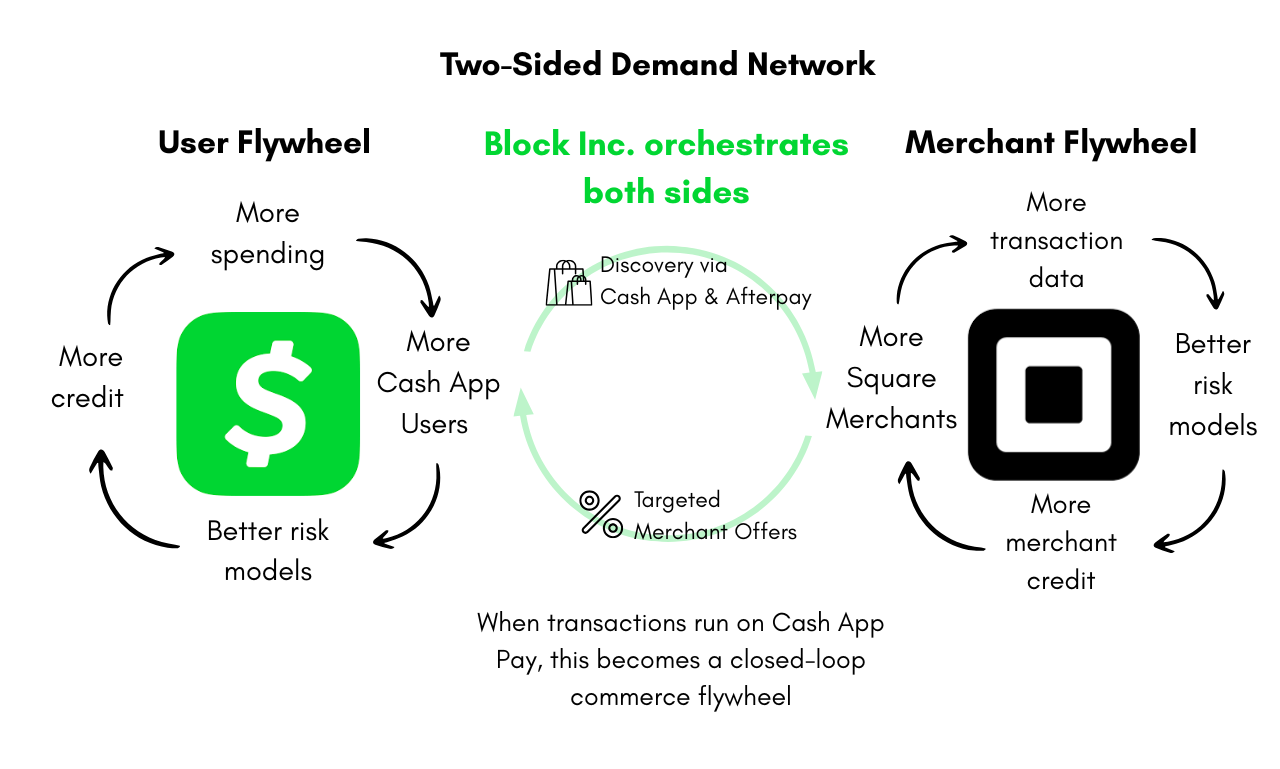The hidden engine inside Block Inc: Why its flywheels matter more than you think
Most investors know Block Inc. (the parent company of Square, Cash App and Afterpay) as a fast-growing fintech with a loyal user base, but far fewer appreciate the deeper structural advantages underpinning the business. When you zoom out a little, Block is not simply a payments company, it is quietly building a series of reinforcing flywheels across its two major ecosystems - Cash App on the consumer side and Square on the merchant side.
Sitting between these two ecosystems is a two-sided demand network that already creates meaningful value. And as Cash App Pay continues to grow, that demand network is gradually turning into something even more powerful: a true commerce flywheel. In our view, this engine is one of the most under-appreciated aspects of Block’s strategy.

1. The Cash App user flywheel
Cash App began life as a simple peer-to-peer payments tool, but today it is a complete financial platform used by more than 58 million Americans. The user flywheel is straightforward:
- More users lead to more peer-to-peer activity — a classic network effect.
- Those users store more money in Cash App including paycheques, deposits and tax refunds.
- As they spend, Block gathers behavioural and transaction data which improves its consumer risk models.
- Better risk models allow Block to offer more responsible credit, including Afterpay instalments and Cash App Borrow.
- More credit leads to more spending, which attracts and retains more users.
As this loop spins, Cash App becomes more useful and more convenient. Users aren’t locked in, they simply stay because the entire product gets better the more people use it.
2. The Square merchant flywheel
Square has built a similar engine on the merchant side:
- More merchants join Square for its payments, point-of-sale and software tools.
- These merchants process transactions that generate rich operational data.
- That data improves Square’s merchant risk models which underpin Square Loans.
- Better underwriting leads to more efficient merchant credit helping sellers grow.
- Growing merchants process more through Square attracting more merchants.
Again, it’s a self-reinforcing system: data → underwriting → credit → volume → more data.
3. The two-sided demand network (the under-appreciated middle layer)
The real magic sits in the space between Cash App users and Square merchants.
Even when a user pays with a Visa-powered Cash App Card, meaning the transaction is not running on Block’s own rails, Block still creates value:
- Cash App offers discovery, showing users Cash App Offers and Afterpay-powered offers from Square merchants.
- Merchants use these offers to acquire customers.
- Users receive discounts.
- Merchants receive incremental demand.
- And Block orchestrates both sides of the market.
This is a two-sided demand network. It’s not a traditional flywheel yet as Visa still processes these transactions, so Block doesn’t capture the full economics, but it’s strategically valuable. It lets Block match the right user with the right merchant, deepen engagement and pull the two ecosystems closer together.
It’s a bridge. A powerful one. But bridges don’t spin. For a flywheel, Block needs the transaction to run on its own rails.
4. Cash App Pay turns the bridge into a commerce flywheel
This is exactly what happens when users pay with Cash App Pay.
Cash App Pay is Block’s own payment rail. When it is used at a Square merchant, Block becomes:
- the issuer (Cash App),
- the merchant acquirer (Square),
- the payment network (Cash App Pay),
- and the risk engine (Block’s underwriting models).
This creates a genuine closed loop. Block sees the full transaction, who the user is, who the merchant is, what was purchased and the behavioural context. Just as importantly, Block keeps more of the economics, because there’s no Visa or Mastercard sitting in the middle.
This transforms the demand network into a commerce flywheel:
- Cash App users discover merchants through instant discounts.
- They pay with Cash App Pay, keeping more economics inside Block.
- These transactions generate richer data, improving risk models on both sides.
- Better models enable more credit for users and merchants.
- More credit → more spending → more offers → more merchants → more users.
- The loop strengthens because Block controls every step.
This logic is similar to what made PayPal powerful on eBay, but Block has the advantage of owning both sides of the ecosystem and the payment rail.
Adoption is accelerating
Cash App Pay has been in the market for several years and is already scaling meaningfully, but the momentum continues to build. A recent milestone is the launch of the product at Target stores nationwide, which brings it into one of the largest and most frequented retail environments in the United States. This is not the start of adoption, but it does signal growing mainstream acceptance and deeper merchant integration.
At the same time, Afterpay co-founder Nick Molnar noted that Cash App Pay GPV is growing 70 percent year-on-year. That level of growth highlights how quickly consumers are shifting spend onto Block’s own payment rail and how strong the underlying demand flywheel already is.
Taken together, these developments show that Cash App Pay is scaling across both sides of the network, with meaningful traction today and a long runway still ahead.
5. Why this matters for investors
Block’s share price often trades on headline numbers such as Gross Payment Volume or Monthly Active Users. But in our view, the real value lies in the architecture, the way these ecosystems reinforce one another over time.
Most payment companies control only a thin slice of the value chain. Some own the consumer. Some own the merchant. Some own the network. Almost none own all three. Block does.
As more transactions shift to Cash App Pay, Block gains stronger data advantages, higher margins, more defensible risk models and tighter integration between Cash App and Square. Block’s underlying mechanics are improving as it scales and the market still underestimates that. Rather than being just another payments company, Block is building a self-reinforcing network connecting tens of millions of consumers and millions of merchants. As Cash App Pay adoption grows, these connections strengthen, the data improves, margins expand and both sides of the ecosystem become more valuable to each other.
The underlying mechanics of this business are compounding in ways investors are only beginning to understand. And that’s exactly the kind of long-term, structural advantage we want our investors exposed to.
6. Looking ahead to Investor Day
Block’s Investor Day is tomorrow, and we are particularly looking forward to hearing more about the future plans for Cash App Pay, including how Block intends to scale the rail, which merchant categories will expand next and how the economics of the system will improve as more volume moves onto Block’s own network.

5 topics
1 stock mentioned
